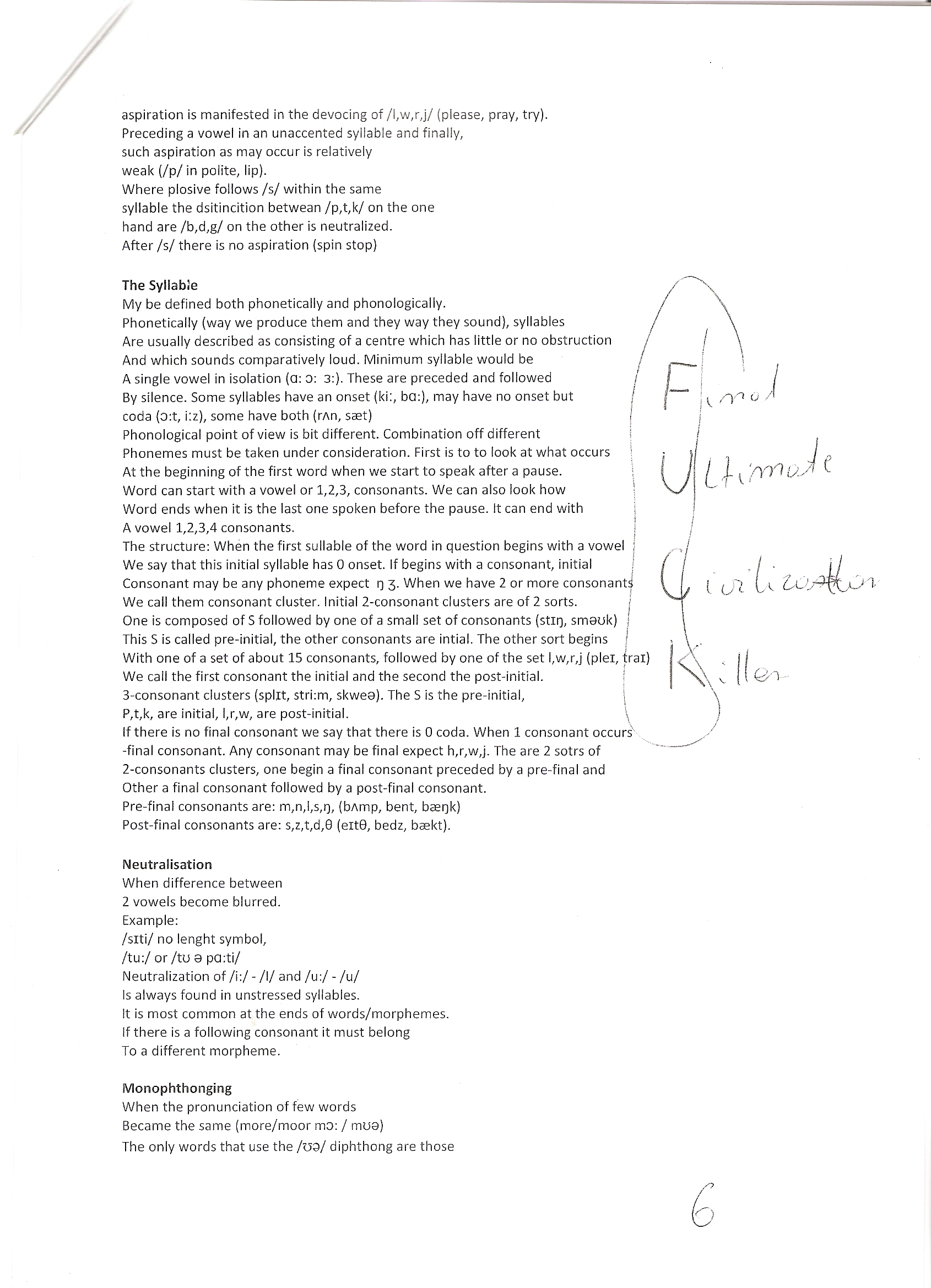29426 skanuj0006 (36)

aspiration is manifested in the devocing of /l,w,r,j/ (please, pray, try).
Preceding a vowel in an unaccented syllable and finaliy, such aspiration as may occur is relatively weak (/p/ in polite, lip).
Where plosive follows /s/ within the same syllable the dsitincition betwean /p,t,k/ on the one hand are /b,d,g/ on the other is neutralized.
After /s/ there is no aspiration (spin stop)

The Syllable
My be defined both phonetically and phonologically.
Phonetically (way we produce them and they way they sound), syllables Are usuaily described as consisting of a centre which has little or no obstruction And which sounds comparatively loud. Minimum syllable would be A single vowel in isolation (a: o: 3:). These are preceded and followed By silence. Some syllables have an onset (ki:, ba:), may have no onset but coda (0:t, i.z), some have both (rAn, saet)
Phonological point of view is bit different. Combination off different Phonemes must be taken under consideration. First is to to look at what occurs At the beginning of the first word when we start to speak after a pause.
Word can start with a vowel or 1,2,3, consonants. We can ałso look how Word ends when it is the last one spoken before the pause. lt can end with A vowel 1,2,3,4 consonants.
The structure: When the first sullable of the word in question begins with a vowel \
We say that this initial syllable has 0 onset. If begins with a consonant, initial Consonant may be any phoneme expect rj 3. When we have 2 or morę consonant^
We cali them consonant cluster. Initial 2-consonant clusters are of 2 sorts.
One is composed of S followed by one of a smali set of consonants (stiq, smeok) | This S is called pre-initial, the other consonants are intial. The other sort begins With one of a set of about 15 consonants, followed by one of the set l,w,r,j (piel, trał) We cali the first consonant the initial and the second the post-initiai.
3-consonant clusters (split, stri:m, skwea). The S is the pre-initial,
P,t,k, are initial, l,r,w, are post-initial. \
If there is no finał consonant we say that there is 0 coda. When 1 consonant occurś' -finał consonant. Any consonant may be finał expect h,r,w,j. The are 2 sotrs of 2-consonants clusters, one begin a finał consonant preceded by a pre-final and Other a finał consonant followed by a post-final consonant.
Pre-final consonants are: m,n,l,s,o, (bAmp, bent, baeok)
Post-final consonants are: s,z,t,d,0 (eit0, bedz, baekt).
Neutralisation
When difference between
2 vowels become blurred.
Example:
/slti/ no lenght symbol,
/tu:/ or /to 0 pa:ti/
Neutralization of /i:/ - /I/ and /u:/ - /u/
Is always found in unstressed syllables.
It is most common at the ends of words/morphemes.
If there is a following consonant it must belong To a different morpheme.
Monophthonging
When the pronunciation of few words Became the same (more/moor mo: / mO0)
The only words that use the /U9/ diphthong are those
Wyszukiwarka
Podobne podstrony:
13 NOTICES BIBLlOGRAPHlQUES 793 The dictłonary of authors is based on the Idea of prescuting in
That is in formal words, but for your information the effect is to introduce the Office of past pres
means, it is far below the level of contemporary Corporation Capital in capitalist countries, becaus
58 Ewa Nasalska 6 exists in the Polish textbooks as well. The displacement is interpreted as th
What can TPM do for YOU? TPM is based on the ideas of optimizing equipment effectiveness, achieving
1.2. Goal and Plan of the Work 3 It is assumed that the goal of this work can be reached in the foll
4SPACEROWA 8THE PROPERTY IS LOCATED AT THE FOOT OF THE MORAINE HILLS OF THE TRI-CITY LANDSCAPE PARK,
page12 (9) A different alr cleaner is now installed in the 2 seater models. It is mounted to the rig
SALJKD13 One Cannot jee a fight 1 as is" t>ay from the point of vicv o: a bcuer, a wrestler,
"Trust not bing tbat you ve bearcL Winter 1431, a son is bom to the Prince of Transyhania. Hisf
PROGRAM ROZWOJOWY^1 POLITECHNIKI WARSZAWSKIEJ 1) The torque is proportional to the
488 The main thesis is that morę information relevant to the shareholders is revealed on the website
12 Joanna Antczak constitute tax obligations. The main objeclive of the article is to present the im
więcej podobnych podstron